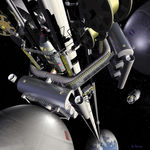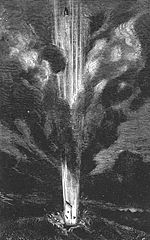- Space gun
-
For other uses, see Space gun (disambiguation).
A space gun is a method of launching an object into outer space using a large gun, or cannon. It provides a method of non-rocket spacelaunch.
In the HARP Project a U.S. Navy 16 inch (406 mm) 100 caliber gun was used to fire a 180 kilogram slug at 3,600 metres per second, reaching an apogee of 180 kilometres, hence performing a suborbital spaceflight.
However, a space gun has never been successfully used to launch an object into orbit.
Contents
Technical issues
The large g-force experienced by a ballistic projectile would likely mean that a space gun would be incapable of safely launching humans or delicate instruments, rather being restricted to freight or ruggedized satellites.
Atmospheric drag also makes it more difficult to control the trajectory of any projectile launched, subjects the projectile to extremely high forces, and causes severe energy losses that may not be easily overcome. The lower troposphere is the densest layer of the atmosphere, and some of these issues may be mitigated by using a space gun with a "gun barrel" reaching above it (e.g. a gun emplacement on a mountaintop).[citation needed]
A space gun, by itself, is generally not capable of placing objects into stable orbit around the planet, unless the objects are able to perform course corrections after launch.[citation needed]
If acceptable solutions to these fundamental issues could be achieved, a space gun could offer access to space at an unprecedented low cost.[citation needed]
Getting to orbit
A space gun, by itself, is not capable of placing objects into stable orbit. The laws of gravitation make it impossible to reach a stable orbit without an active payload which performs orbital correction burns to change the shape of its orbit after launch. The orbit is a parabolic orbit, a hyperbolic orbit, or part of an elliptic orbit which ends at the planet's surface at the point of launch or another point. This means that an uncorrected ballistic payload will always strike the planet within its first orbit unless the velocity was so high as to reach or exceed escape velocity.
Isaac Newton avoided this objection in his thought experiment by positing an impossibly tall mountain from which his cannon was fired. The projectile, however, would still tend to circle the planet and strike the point of launch.[citation needed]
As a result, all payloads intended to reach a closed orbit would have at least to perform some sort of course correction to create another orbit that does not intersect the planet's surface. In addition a rocket can be used for additional boost, as planned in the Quicklaunch project. The magnitude of such may be small; for instance, the StarTram Generation 1 reference design involves a total of 0.6 km/s of rocket burn to raise perigee well above the atmosphere when entering a 8 km/s Low Earth Orbit.[1]
It is conceivable that in a multi-body gravitational system, like the Earth-Moon system, that a trajectory could be found that does not re-intersect the Earth's surface, although these paths would likely not be very simple nor desirable, and would require much more energy.
Acceleration
A space gun with a "gun barrel" of length (l), and the needed velocity (ve), the acceleration (a) is provided by the following formula:
For instance, with a space gun with a vertical "gun barrel" through both the Earth's crust and the troposphere, totalling ~60 km of length (l), and a velocity (ve) enough to escape the Earth's gravity (escape velocity, which is 11.2 km/s on Earth), the acceleration (a) would theoretically be more than 1000 m/s2, which is more than 100 g-forces, which is about 3 times the human tolerance to g-forces of maximum 20 to 35 g[2] during the ~10 seconds such a firing would take.
Any doubling of the barrel length would theoretically cut the generated g-force in half while doubling the firing time.[citation needed]
Practical attempts
The German V-3 cannon program (less well known than the V-2 rocket or V-1 flying bomb), during the Second World War was an attempt to build something approaching a space gun. Based in the Pas-de-Calais area of France it was planned to be more devastating than the other Nazi 'Vengeance weapons'. It was destroyed by RAF bombing using 'Tallboy' blockbuster bombs in July 1944.[citation needed]
On the practical side, the most prominent recent attempt to make a space gun was artillery engineer Gerald Bull's Project Babylon, which was also known as the 'Iraqi supergun' by the media. During Project Babylon, Bull used his experience from Project HARP to build a massive cannon for Saddam Hussein leader of Ba'athist Iraq. This gun, had it been completed, would have been the first true space gun capable of launching objects into space.[citation needed] However, Bull was assassinated before the project was completed.
Super High Altitude Research Project
Since Bull's death, few have seriously attempted to build a space gun. Perhaps most promisingly, the US Ballistic Missile Defense program sponsored the Super High Altitude Research Project in the 1980s. Developed at Lawrence Livermore Laboratory, it is a light gas gun and has been used to test fire objects at Mach 9.
Quicklaunch
One of the lead developers John Hunter has since founded the Jules Verne Launcher Company in 1996 and the Quicklaunch company.He now seek to raise 500 millions $ to build one that could refuel a propellant depot or send bulk materials into space.[3][4][5]
Ram accelerators have also been proposed as an alternative to light gas guns. Other proposals use electromagnetic techniques for accelerating the payload, such as coilguns and railguns.
In fiction
The first publication of the concept may be Newton's cannonball in the 1728 book A Treatise of the System of the World, although it was primarily used as a thought experiment regarding gravity.[6]
Perhaps the most famous representation of a space gun is Jules Verne's novel, From the Earth to the Moon (made into a silent movie called Le Voyage dans la Lune), in which astronauts fly to the moon aboard a ship launched from a cannon. Another famous example is the hydrogen accelerator cannon used by the Martians to launch their invasion in H. G. Wells' book The War of the Worlds. Wells also used the concept in the climax of the 1936 movie Things to Come. The device was featured in films as late as 1967, such as Jules Verne's Rocket to the Moon.
In the Square (now Square Enix) video game Final Fantasy VIII, humans are sent to a space base by the use of hybrid rail/coil gun. In the video game Ultima: Worlds of Adventure 2: Martian Dreams, Percival Lowell builds a space gun to send a ship to Mars.
In the Nintendo game Paper Mario: The Thousand Year Door the protagonist is fired to the moon from a large cannon powered by the explosion of thousands of anthropomorphic bombs. This is depicted in a somewhat comical fashion.
Additionally, a book about the Halo universe, Halo: Contact Harvest included a 'magnetic accelerator cannon(coil gun)' ,also known as MAC, used as both a surface-to-air/space weapon and to lift objects into space from a planetary surface(known as mass driver).
Gerald Bull's assassination and the Project Babylon gun were also the starting point for Frederick Forsyth's 1994 novel The Fist of God.
See also
- Newton's cannonball
- SHARP
- Quicklaunch
- StarTram
- Space elevator
- Launch loop
- Lightcraft
- Space fountain
- Tether propulsion
- Non-rocket spacelaunch
References
- ^ "StarTram2010: Maglev Launch: Ultra Low Cost Ultra High Volume Access to Space for Cargo and Humans". startram.com. http://www.startram.com/resources. Retrieved April 28, 2011.
- ^ Anton Sukup (1977). "David PURLEY Silverstone crash". http://www.asag.sk/bio/purley.htm. Retrieved July 31, 2006.
- ^ "quicklaunchinc.com". http://quicklaunchinc.com/. Retrieved November 11, 2011.
- ^ "Jules Verne Launcher Company Concept". astronautix.com. http://www.astronautix.com/lvs/julncher.htm. Retrieved November 11, 2011.
- ^ "A Cannon for Shooting Supplies into Space". popsci.com. http://www.popsci.com/technology/article/2010-01/cannon-shooting-supplies-space. Retrieved November 11, 2011.
- ^ vectorsite.net > [4.0 Space Guns] v1.1.4 / chapter 4 of 7 / 01 jun 08 / greg goebel / public domain
External links
Non-rocket spacelaunch Static structures CompressiveSpace towerTensileBolusRotovators · Hypersonic bolusOtherEndo-atmospheric tethers
Dynamic structures Projectile launchers ElectricalChemicalMechanicalSlingatronReaction drives Buoyant lifting Categories:- Spaceguns
- Megastructures
- Spacecraft propulsion
- Space technology
- Vertical transport devices
- Space access
Wikimedia Foundation. 2010.





